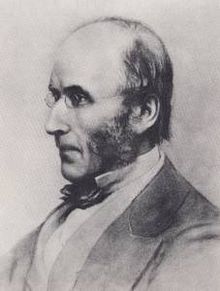William Butterfield
| William Butterfield | |
|---|---|
 |
|
| Born | 7 September 1814 |
| Died | 23 February 1900 (aged 85) |
| Nationality | British |
| Occupation | Architect |
| Awards | Royal Gold Medal (1884) |
| Buildings | St Ninian's Cathedral, Perth in Scotland, St Paul's Cathedral, Melbourne in Australia |
| Projects | Keble College, Oxford |
William Butterfield (7 September 1814 – 23 February 1900) was a Gothic Revival architect and associated with the Oxford Movement (or Tractarian Movement). He is noted for his use of polychromy.
William Butterfield was born in London in 1814. His parents were strict non-conformists who ran a chemist's shop in the Strand. He was one of nine children and was educated at a local school. At the age of 16, he was apprenticed to Thomas Arber, a builder in Pimlico, who later became bankrupt. He studied architecture under E. L. Blackburne (1833–1836). From 1838 to 1839, he was an assistant to Harvey Eginton, an architect in Worcester, where he became articled. He established his own architectural practice at Lincoln's Inn Fields in 1840.
From 1842 Butterfield was involved with the Cambridge Camden Society, later The Ecclesiological Society. He contributed designs to the Society's journal, The Ecclesiologist. His involvement influenced his architectural style. He also drew religious inspiration from the Oxford Movement and as such, he was very high church despite his non-conformist upbringing. He was a Gothic revival architect, and as such he reinterpreted the original Gothic style in Victorian terms. Many of his buildings were for religious use, although he also designed for colleges and schools.
Butterfield's church of All Saints, Margaret Street, London, was, in the view of Henry-Russell Hitchcock, the building that initiated the High Victorian Gothic era. It was designed in 1850, completed externally by 1853 and consecrated in 1859. Flanked by a clergy house and school, it was intended as a "model" church by its sponsors, the Ecclesiological Society. The church was built of red-brick, a material long out of use in London, patterned with bands of black brick, the first use of polychrome brick in the city, with bands of stone on the spire. The interior was even more richly decorated, with marble and tile marquetry.
...
Wikipedia
